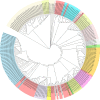Metabarcoding study to reveal the structural community of strongylid nematodes in domesticated horses in Thailand
- PMID: 38395874
- PMCID: PMC10893705
- DOI: 10.1186/s12917-024-03934-y
Metabarcoding study to reveal the structural community of strongylid nematodes in domesticated horses in Thailand
Abstract
Background: Mixed strongylid infections significantly impact equine health and performance. Traditional microscopy-based methods exhibit limitations in accurately identifying strongylid species. Nemabiome deep amplicon sequencing approach previously succeeded in describing the strongylid communities in livestock including equids. However, there are no available studies that describe the structural communities of strongylid parasites in horses in Thailand. Therefore, this study was undertaken encompassing the ITS-2 rDNA metabarcoding assay to characterize strongylid species within horse fecal samples collected from a cohort of yearlings at the largest domesticated stud farm in Thailand. In addition, to investigate the capability of ITS-2 rDNA in assessing the phylogenetic relationships among the identified strongylid species.
Results: The study identified 14 strongylid species in the examined equine populations, each with varying prevalence. Notably, Cylicocyclus nassatus and Cylicostephanus longibursatus were identified as the predominant species, with Strongylus spp. conspicuously absent. The phylogenetic analysis of 207 amplicon sequence variants (ASVs) displayed a complex relationship among the investigated cyathostomin species, with some species are positioned across multiple clades, demonstrating close associations with various species and genera.
Conclusion: The ITS-2 nemabiome sequencing technique provided a detailed picture of horse strongylid parasite species in the studied population. This establishes a foundation for future investigations into the resistance status of these parasites and enables efforts to mitigate their impact.
Keywords: Deep amplicon sequencing; Horses; Nemabiome; Strongylid parasites.
© 2024. The Author(s).
Conflict of interest statement
The authors declare no competing interests.
Figures


Similar articles
-
Prevalence, risk factors, and species diversity of strongylid nematodes in domesticated Thai horses: insights from ITS-2 rDNA metabarcoding.Parasitol Res. 2024 Dec 17;123(12):410. doi: 10.1007/s00436-024-08438-0. Parasitol Res. 2024. PMID: 39688721
-
Faecal egg counts and nemabiome metabarcoding highlight the genomic complexity of equine cyathostomin communities and provide insight into their dynamics in a Scottish native pony herd.Int J Parasitol. 2022 Nov;52(12):763-774. doi: 10.1016/j.ijpara.2022.08.002. Epub 2022 Oct 5. Int J Parasitol. 2022. PMID: 36208676
-
Prevalence and diversity of ascarid and strongylid nematodes in Australian Thoroughbred horses using next-generation sequencing and bioinformatic tools.Vet Parasitol. 2023 Nov;323:110048. doi: 10.1016/j.vetpar.2023.110048. Epub 2023 Oct 14. Vet Parasitol. 2023. PMID: 37844388
-
Meta-analysis of cyathostomin species-specific prevalence and relative abundance in domestic horses from 1975-2020: emphasis on geographical region and specimen collection method.Parasit Vectors. 2020 Oct 12;13(1):509. doi: 10.1186/s13071-020-04396-5. Parasit Vectors. 2020. PMID: 33046130 Free PMC article. Review.
-
Anthelmintic resistance in nematodes of horses.Vet Res. 2002 Sep-Oct;33(5):491-507. doi: 10.1051/vetres:2002035. Vet Res. 2002. PMID: 12387486 Review.
Cited by
-
Quantitative DNA metabarcoding reveals species composition of a macrocyclic lactone and pyrantel resistant cyathostomin population in the UK.Int J Parasitol Drugs Drug Resist. 2025 Apr;27:100576. doi: 10.1016/j.ijpddr.2024.100576. Epub 2024 Dec 22. Int J Parasitol Drugs Drug Resist. 2025. PMID: 39778419 Free PMC article.
-
Prevalence, risk factors, and species diversity of strongylid nematodes in domesticated Thai horses: insights from ITS-2 rDNA metabarcoding.Parasitol Res. 2024 Dec 17;123(12):410. doi: 10.1007/s00436-024-08438-0. Parasitol Res. 2024. PMID: 39688721
References
-
- Matthews J, Burden F. Common helminth infections of donkeys and their control in temperate regions. Equine Veterinary Educ. 2013;25(9):461–7. doi: 10.1111/eve.12018. - DOI
MeSH terms
Substances
Grants and funding
LinkOut - more resources
Full Text Sources
Miscellaneous

